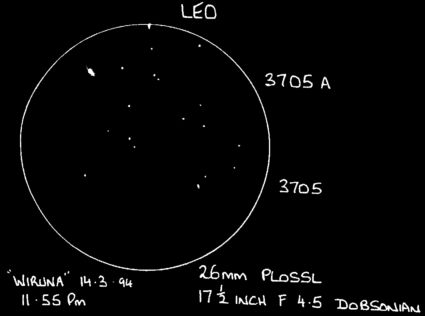SSPM2. A Couple of Spirals in Leo
By Scott Mellish, 1994
I had the opportunity of a full night's observing with the club's 17.5 f/4.5 telescope after the regulars went home on the Sunday and Monday morning over the weekend 12th - 13th March. Monday afternoon started to look promising at around 4pm with a lovely blue sky, mild temperature and generally perfect conditions.
Although Steve Mencinsky was up at the house, I still have misgivings about being in the paddock on my own. However as evening fell, my anxiety gave way to engrossing observations as I was in for an entire cloud-free, dewless and windless evening. In fact it wasn't even too cold, a very rare conjunction of the elements for regular Ilford visitors. I had planned earlier in the evening to get back to the Leo 1 dwarf galaxy that I had observed with some difficulty with Mick McCullagh the previous evening.
After arriving at Regulus, and being careful to push it out of the field before looking in the eyepiece, I was surprised to see Leo I more vividly than the previous night. Although by all intents and purposes still quite faint, it was easily observable without averted vision, and I was most pleased with this start to the evening's proceedings. One point to make here is that I was unable to locate the small faint galaxy IC591 for some strange reason, as the previous evening it was visible better than Leo 1.
I then moved on to three quite bright and very conspicuous spiral galaxies that I stumbled across and sketched during a marathon observing session.
The first object is a very remarkable spiral galaxy NGC 3628, an edgewise spiral with an elongated intense core region with no discernible central point source. Some dust lanes in the outer halo can be observed with a bit of concentration and averted vision. The spiral arms, although they are not well viewed due to the galaxy's edge-on position, are more than suspected as you observe this very impressive object over a long period. I was curious as to how this galaxy never got a Messier number.
NGC 3593 was the next galaxy I came across, which is in the same general area as NGC 3628. This is another nice object with a bright, well defined core and a compact halo that was only marginally fainter than the core region. Not much else in the line of detail was visible with this object. However, its overall luminosity was rather a surprise and I stayed observing this object for some time after I completed my sketch.
The last object in this edition is NGC 3666, another edge-on galaxy that was the faintest of all three sketched for this article. A small, cigar shaped, virtually featureless galaxy with no discernible core of any significance. Not a particularly interesting object, although I find nearly all galaxies fascinating, due to their enormity and place in the universe, regardless of how far or faint they may be.
In the next edition, we'll look at more galaxies in Leo. For further details on the objects contained in this article, look up the relevant page of Uranometria (north) or better still go out and observe them yourself.
Editor's note: In transfers through the history of the ASNSW website, the images below have appeared with this article. However, the target objects mentioned in the article are not those that appear in the images. In addition, there was never a subsequent article on Leo galaxies on the website. Apologies for any confusion!



